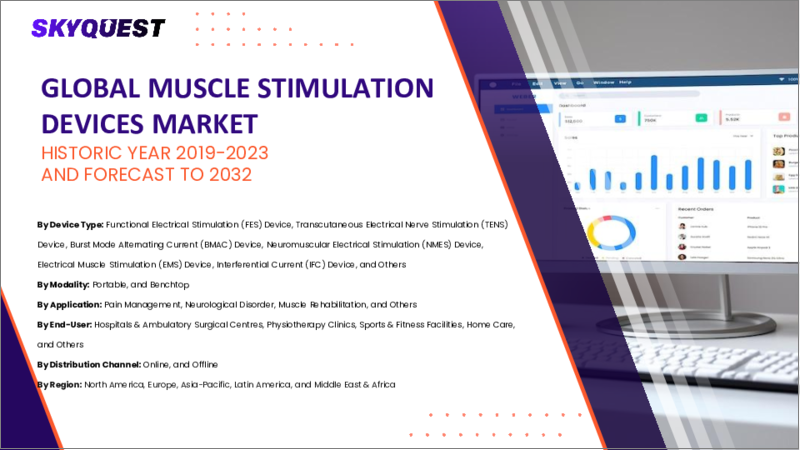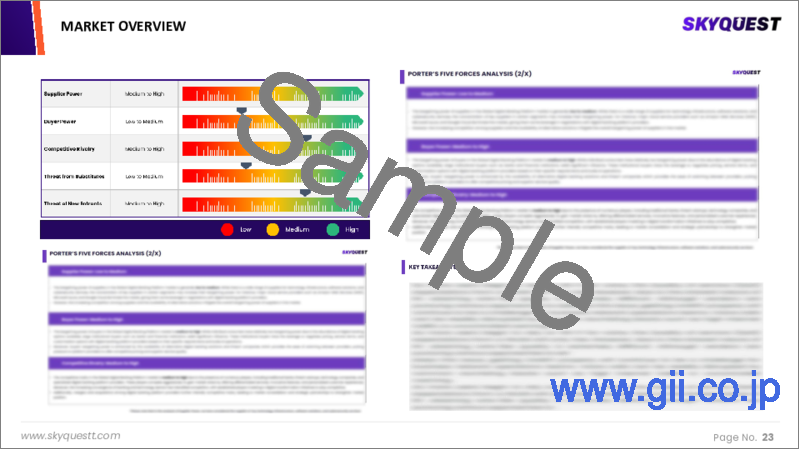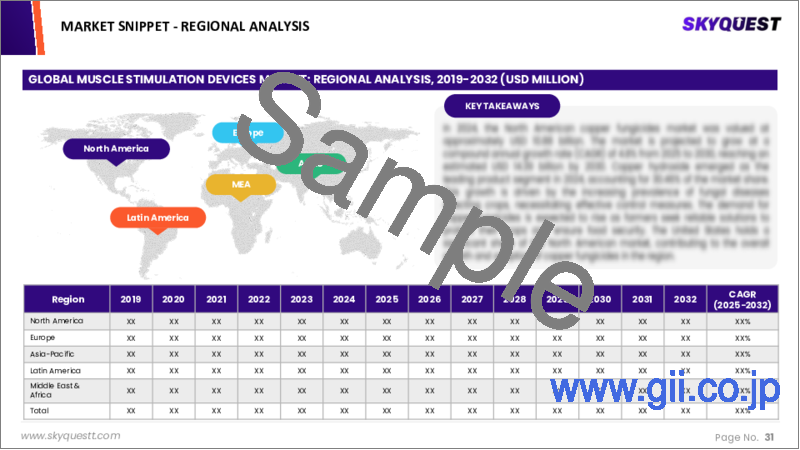|
|
市場調査レポート
商品コード
1681586
筋肉刺激装置の市場規模、シェア、成長分析:製品タイプ別、用途別、最終用途別、地域別 - 産業予測 2025~2032年Muscle Stimulation Devices Market Size, Share, and Growth Analysis, By Product Type (Transcutaneous Electrical Nerve Stimulation, Interferential Current Electrical Stimulation ), By Application, By End Use, By Region - Industry Forecast 2025-2032 |
||||||
|
|||||||
| 筋肉刺激装置の市場規模、シェア、成長分析:製品タイプ別、用途別、最終用途別、地域別 - 産業予測 2025~2032年 |
|
出版日: 2025年03月10日
発行: SkyQuest
ページ情報: 英文 219 Pages
納期: 3~5営業日
|
全表示
- 概要
- 目次
筋肉刺激装置市場規模は2023年に7億6,090万米ドルとなり、予測期間(2025~2032年)のCAGRは5.8%で、2024年の8億503万米ドルから2032年には12億6,386万米ドルに成長すると予測されています。
世界の筋肉刺激装置市場は、身体の健康に対する意識の高まり、リハビリテーションのニーズ、ヘルスケア技術の進歩などを背景に、大きな成長を遂げています。神経筋電気刺激(NMES)機器として知られるこれらのツールは、筋収縮を刺激する電気インパルスを通じて、筋力強化、疼痛管理、リハビリテーション、運動能力向上のために広く採用されています。主要な成長要因は、フィットネスとスポーツ・パフォーマンスへの注目が高まっていることであり、アスリートやフィットネス愛好家は、回復を改善し、傷害リスクを軽減し、パフォーマンスを最大化するために、筋肉刺激を日課に取り入れています。さらに、高齢化社会では、リハビリテーションや疼痛緩和のために、こうした非侵襲的で薬物を使用しないソリューションを求めています。技術革新により、デバイスの使いやすさ、携帯性、カスタマイズ性が向上し、モバイルアプリやウェアラブルとの統合により、家庭用としての普及がさらに進んでいます。
目次
イントロダクション
- 調査の目的
- 調査範囲
- 定義
調査手法
- 情報調達
- 二次と一次データの方法
- 市場規模予測
- 市場の前提条件と制限
エグゼクティブサマリー
- 世界市場の見通し
- 供給と需要の動向分析
- セグメント別機会分析
市場力学と見通し
- 市場概要
- 市場規模
- 市場力学
- 促進要因と機会
- 抑制要因と課題
- ポーターの分析
主な市場の考察
- 重要成功要因
- 競合の程度
- 主な投資機会
- 市場エコシステム
- 市場の魅力指数(2024年)
- PESTEL分析
- マクロ経済指標
- バリューチェーン分析
- 価格分析
- 規制情勢
- ケーススタディ
- 技術の進歩
筋肉刺激装置市場規模:製品タイプ別
- 市場概要
- 経皮的電気神経刺激(TENS)
- 干渉電流電気刺激(IFC)
- バーストモード交流電流(BMAC)
- 神経筋電気刺激(NMES)
筋肉刺激装置市場規模:用途別
- 市場概要
- 疼痛管理
- 神経疾患および運動障害の管理
- 筋骨格障害の管理
筋肉刺激装置市場規模:最終用途別
- 市場概要
- 病院
- 理学療法クリニック
- スポーツクリニック
- ホームケア
- その他
筋肉刺激装置市場規模
- 北米
- 米国
- カナダ
- 欧州
- ドイツ
- スペイン
- フランス
- 英国
- イタリア
- その他欧州地域
- アジア太平洋地域
- 中国
- インド
- 日本
- 韓国
- その他アジア太平洋地域
- ラテンアメリカ
- ブラジル
- その他ラテンアメリカ地域
- 中東・アフリカ
- GCC諸国
- 南アフリカ
- その他中東・アフリカ
競合情報
- 上位5社の比較
- 主要企業の市場ポジショニング(2024年)
- 主な市場企業が採用した戦略
- 最近の市場動向
- 企業の市場シェア分析(2024年)
- 主要企業の企業プロファイル
- 企業の詳細
- 製品ポートフォリオ分析
- 企業のセグメント別シェア分析
- 収益の前年比比較(2022~2024年)
主要企業プロファイル
- NeuroMetrix, Inc.(United States)
- Omron Corporation(Japan)
- BioMedical Life Systems, Inc.(United States)
- Zynex, Inc.(United States)
- EMS Physio Ltd.(United Kingdom)
- DJO Global, Inc.(United States)
- Beurer GmbH(Germany)
- R.S. Medical Inc.(United States)
- Enovis Corporation(United States)
- Abbott Laboratories(United States)
- BTL Corporate(United Kingdom)
- Bharat Medical Systems(India)
- Myolyn(United States)
- Compex(United Kingdom)
- INTCO Medical Technology Co., Ltd.(China)
- Medtronic plc(Ireland)
- Philips Healthcare(Netherlands)
- GE Healthcare(United States)
- Siemens Healthineers(Germany)
結論と提言
Muscle Stimulation Devices Market size was valued at USD 760.9 million in 2023 and is poised to grow from USD 805.03 million in 2024 to USD 1263.86 million by 2032, growing at a CAGR of 5.8% during the forecast period (2025-2032).
The global muscle stimulation devices market is witnessing significant growth, driven by heightened awareness of physical health, rehabilitation needs, and advancements in healthcare technology. Known as neuromuscular electrical stimulation (NMES) devices, these tools are widely employed for muscle strengthening, pain management, rehabilitation, and enhancing athletic performance through electrical impulses that stimulate muscle contractions. A key growth factor is the increasing focus on fitness and sports performance, as athletes and fitness enthusiasts incorporate muscle stimulation into their routines to improve recovery, reduce injury risk, and maximize performance. Additionally, the aging population seeks these non-invasive, drug-free solutions for rehabilitation and pain relief. Technological innovations have enhanced device usability, portability, and customization, while integration with mobile apps and wearables further boosts their adoption for home use.
Top-down and bottom-up approaches were used to estimate and validate the size of the Muscle Stimulation Devices market and to estimate the size of various other dependent submarkets. The research methodology used to estimate the market size includes the following details: The key players in the market were identified through secondary research, and their market shares in the respective regions were determined through primary and secondary research. This entire procedure includes the study of the annual and financial reports of the top market players and extensive interviews for key insights from industry leaders such as CEOs, VPs, directors, and marketing executives. All percentage shares split, and breakdowns were determined using secondary sources and verified through Primary sources. All possible parameters that affect the markets covered in this research study have been accounted for, viewed in extensive detail, verified through primary research, and analyzed to get the final quantitative and qualitative data.
Muscle Stimulation Devices Market Segments Analysis
Global Muscle Stimulation Devices Market is segmented by Product Type, Application, End Use and region. Based on Product Type, the market is segmented into Transcutaneous Electrical Nerve Stimulation (TENS), Interferential Current Electrical Stimulation (IFC), Burst Mode Alternating Current (BMAC) and Neuromuscular Electrical Stimulation (NMES). Based on Application, the market is segmented into Pain Management, Neurological and Movement Disorder Management and Musculoskeletal Disorder Management. Based on End Use, the market is segmented into Hospitals, Physiotherapy Clinics, Sports Clinics, Home Care and Others. Based on region, the market is segmented into North America, Europe, Asia Pacific, Latin America and Middle East & Africa.
Driver of the Muscle Stimulation Devices Market
The global aging population is contributing to a rise in age-related conditions, such as muscle weakness and mobility challenges. Consequently, there has been a growing reliance on muscle stimulation devices within rehabilitation and physical therapy environments, as these technologies support patients in regaining muscle strength and improving mobility. This trend underscores the importance of addressing the needs of the elderly demographic, which has emerged as a key factor propelling the muscle stimulation devices market forward. As more individuals seek effective interventions for age-related physical decline, the demand for these devices continues to increase, shaping the landscape of this market.
Restraints in the Muscle Stimulation Devices Market
The Muscle Stimulation Devices market faces significant challenges due to regulatory oversight in numerous countries. Adhering to a variety of regulatory standards can be complicated for manufacturers, as they must ensure their products meet safety and efficacy criteria. Obtaining the necessary approvals and effectively navigating the complex regulatory environment can create obstacles that hinder manufacturers' ability to innovate and launch new products swiftly. Consequently, these factors may result in delays in product development and market entry, ultimately impacting the growth potential of the muscle stimulation devices industry as a whole.
Market Trends of the Muscle Stimulation Devices Market
The muscle stimulation devices market is witnessing a notable trend driven by the increasing adoption of these technologies within the sports and fitness sector. Athletes, trainers, and fitness aficionados are increasingly integrating muscle stimulation devices into their training and recovery regimes, viewing them as crucial tools for enhancing muscle performance, accelerating recovery times, and minimizing injury risks. In response, manufacturers are innovating specialized devices tailored to meet the unique demands of this market segment. Additionally, the rise of wearable muscle stimulation devices is allowing users to seamlessly incorporate these technologies into their daily fitness routines, further fueling market growth and consumer interest.
Table of Contents
Introduction
- Objectives of the Study
- Scope of the Report
- Definitions
Research Methodology
- Information Procurement
- Secondary & Primary Data Methods
- Market Size Estimation
- Market Assumptions & Limitations
Executive Summary
- Global Market Outlook
- Supply & Demand Trend Analysis
- Segmental Opportunity Analysis
Market Dynamics & Outlook
- Market Overview
- Market Size
- Market Dynamics
- Drivers & Opportunities
- Restraints & Challenges
- Porters Analysis
- Competitive rivalry
- Threat of substitute
- Bargaining power of buyers
- Threat of new entrants
- Bargaining power of suppliers
Key Market Insights
- Key Success Factors
- Degree of Competition
- Top Investment Pockets
- Market Ecosystem
- Market Attractiveness Index, 2024
- PESTEL Analysis
- Macro-Economic Indicators
- Value Chain Analysis
- Pricing Analysis
- Regulatory Landscape
- Case Studies
- Technological Advancement
Global Muscle Stimulation Devices Market Size by Product Type & CAGR (2025-2032)
- Market Overview
- Transcutaneous Electrical Nerve Stimulation (TENS)
- Interferential Current Electrical Stimulation (IFC)
- Burst Mode Alternating Current (BMAC)
- Neuromuscular Electrical Stimulation (NMES)
Global Muscle Stimulation Devices Market Size by Application & CAGR (2025-2032)
- Market Overview
- Pain Management
- Neurological and Movement Disorder Management
- Musculoskeletal Disorder Management
Global Muscle Stimulation Devices Market Size by End Use & CAGR (2025-2032)
- Market Overview
- Hospitals
- Physiotherapy Clinics
- Sports Clinics
- Home Care
- Others
Global Muscle Stimulation Devices Market Size & CAGR (2025-2032)
- North America (Product Type, Application, End Use)
- US
- Canada
- Europe (Product Type, Application, End Use)
- Germany
- Spain
- France
- UK
- Italy
- Rest of Europe
- Asia Pacific (Product Type, Application, End Use)
- China
- India
- Japan
- South Korea
- Rest of Asia-Pacific
- Latin America (Product Type, Application, End Use)
- Brazil
- Rest of Latin America
- Middle East & Africa (Product Type, Application, End Use)
- GCC Countries
- South Africa
- Rest of Middle East & Africa
Competitive Intelligence
- Top 5 Player Comparison
- Market Positioning of Key Players, 2024
- Strategies Adopted by Key Market Players
- Recent Developments in the Market
- Company Market Share Analysis, 2024
- Company Profiles of All Key Players
- Company Details
- Product Portfolio Analysis
- Company's Segmental Share Analysis
- Revenue Y-O-Y Comparison (2022-2024)
Key Company Profiles
- NeuroMetrix, Inc. (United States)
- Company Overview
- Business Segment Overview
- Financial Updates
- Key Developments
- Omron Corporation (Japan)
- Company Overview
- Business Segment Overview
- Financial Updates
- Key Developments
- BioMedical Life Systems, Inc. (United States)
- Company Overview
- Business Segment Overview
- Financial Updates
- Key Developments
- Zynex, Inc. (United States)
- Company Overview
- Business Segment Overview
- Financial Updates
- Key Developments
- EMS Physio Ltd. (United Kingdom)
- Company Overview
- Business Segment Overview
- Financial Updates
- Key Developments
- DJO Global, Inc. (United States)
- Company Overview
- Business Segment Overview
- Financial Updates
- Key Developments
- Beurer GmbH (Germany)
- Company Overview
- Business Segment Overview
- Financial Updates
- Key Developments
- R.S. Medical Inc. (United States)
- Company Overview
- Business Segment Overview
- Financial Updates
- Key Developments
- Enovis Corporation (United States)
- Company Overview
- Business Segment Overview
- Financial Updates
- Key Developments
- Abbott Laboratories (United States)
- Company Overview
- Business Segment Overview
- Financial Updates
- Key Developments
- BTL Corporate (United Kingdom)
- Company Overview
- Business Segment Overview
- Financial Updates
- Key Developments
- Bharat Medical Systems (India)
- Company Overview
- Business Segment Overview
- Financial Updates
- Key Developments
- Myolyn (United States)
- Company Overview
- Business Segment Overview
- Financial Updates
- Key Developments
- Compex (United Kingdom)
- Company Overview
- Business Segment Overview
- Financial Updates
- Key Developments
- INTCO Medical Technology Co., Ltd. (China)
- Company Overview
- Business Segment Overview
- Financial Updates
- Key Developments
- Medtronic plc (Ireland)
- Company Overview
- Business Segment Overview
- Financial Updates
- Key Developments
- Philips Healthcare (Netherlands)
- Company Overview
- Business Segment Overview
- Financial Updates
- Key Developments
- GE Healthcare (United States)
- Company Overview
- Business Segment Overview
- Financial Updates
- Key Developments
- Siemens Healthineers (Germany)
- Company Overview
- Business Segment Overview
- Financial Updates
- Key Developments





